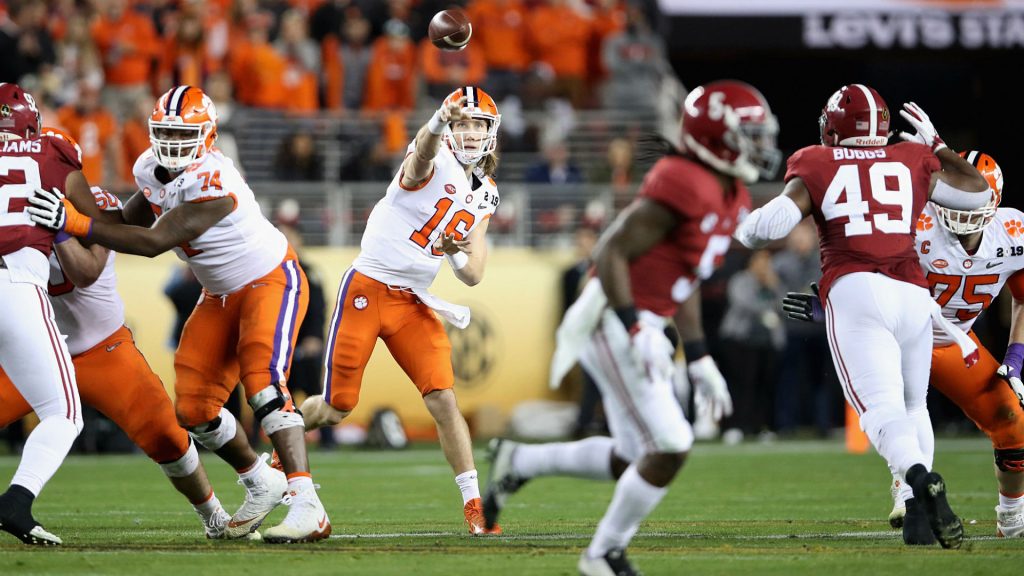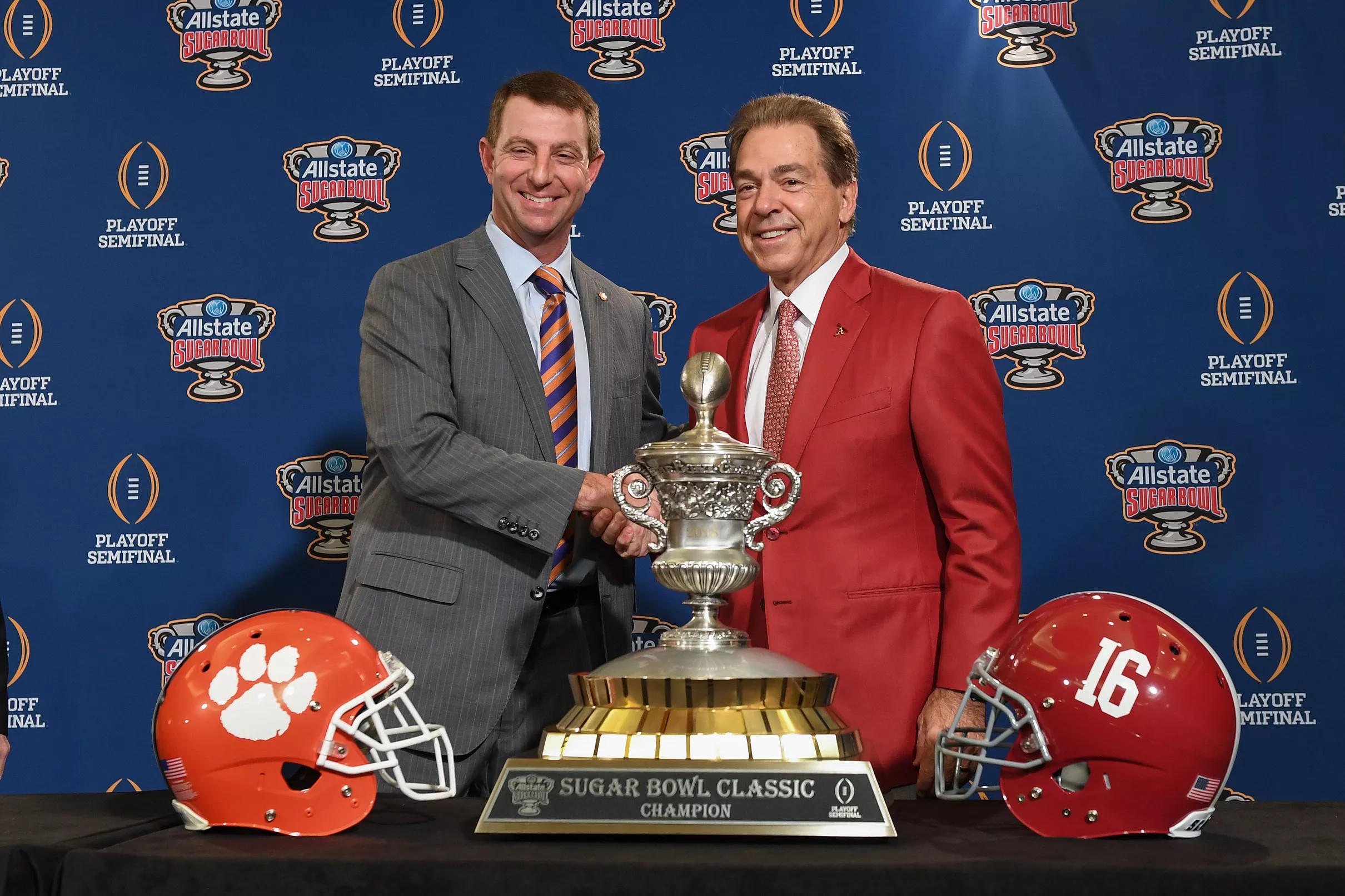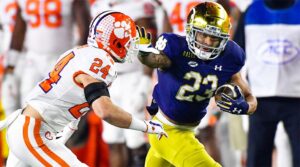Two titans run college football. They don’t make the rules or steal every headline and haven’t fundamentally changed the way the game is played, but when it comes time to get fitted for rings and eat the McDonald’s President Trump provides on the champions’ visit to the White House, only two teams have been on that stage in the last four years. And those two have enjoyed the type of relentless success in the last half-decade that no other program can even approach matching.
Alabama and Clemson have played each other in three of the last four national championship games and have both been in the last four editions of the College Football Playoff. In that time, neither team has lost to a team besides the other in the postseason. If Clemson comes up short of the title, it’s because the Tide knocked them off, and vice versa. Hardly in the last half-century of the sport has one team been so dominant over an extended stretch, let alone a pair of teams simultaneously.
It wasn’t supposed to work out like this. Five years ago, when the four-team College Football Playoff replaced the Bowl Championship Series, the switch was widely heralded because formulas wouldn’t be deciding the two teams that would get a shot at the title anymore – the best quartet would have to do battle to crown a true champ. But the three times Alabama and Clemson have played each other in the national title, they’ve been the 1 and 2 seeds. Their average margin of victory in those six semifinals? Twenty-four points. We didn’t need any formula to tell us who the best two were.
The brand-new transfer portal that features more player mobility than ever and the marquee non-conference matchups that test the blue-chip teams before conference play – both were supposed to help move toward parity in college football. Instead, the teams that have the bad fortune to draw Alabama and Clemson in the CFP are getting whitewashed.
Last season, Alabama played only one game within ten points (Georgia, in the SEC Championship) and was primed to be anointed the greatest team in college football history before they were pumped by Clemson in the national title. The Tigers were hardly further behind – they had only played one game within twenty points after prodigious quarterback Trevor Lawrence took over starting duties (Syracuse, where Lawrence had to leave the game after a hit to the head).
Lawrence is back for his true sophomore season, as is running back Travis Etienne (8.1 yards per carry on 204 carries) and the rest of the weapons that helped hang 44 points on ‘Bama in the final. The Tigers are breaking in a mostly new defense but it won’t matter in a weak ACC. They’ve assembled a group of skill position players that could rival NFL clubs’ and are listed at -600 odds (an 85.7% implied probability) to make the College Football Playoff for the fifth year running.
The Crimson Tide are no less intimidating heading into 2019. Last season, they made an absolute mockery of the presumed toughest division in college football, the SEC West. Heisman Trophy runner-up Tua Tagovailoa returns at quarterback and will air it out to an enviable group of receivers headlined by Biletnikoff Trophy winner Jerry Jeudy. It goes without saying that the Tide will successfully retool their defense, but they just pulled in the #1 recruiting class in the country if you needed any more convincing. After a season-ending injury to star linebacker Dylan Moses last week, the Tide’s odds to make the CFP slipped from -350 to a still-absurd -300 (75% implied probability).
I consider myself a fan of parity, but it’s hard not to be impressed with what Alabama and Clemson have done. Four years is a seriously long time in college football: top players are expected to contribute for only a season or two before leaving for the draft or graduating. The two schools have not only ascended to the pinnacle of the FBS, they’ve stayed there with virtually no drop-off.
So how have Alabama and Clemson created, as my strategy professor would say, a “sustainable competitive advantage?” Most would respond without hesitation: Alabama out-recruits everyone. Clemson had two elite QBs and plays in a limping ACC.
There’s undoubtedly some truth to those knee-jerk answers. According to SB Nation’s weighted four-year recruiting averages, ‘Bama has pulled in the time-adjusted best recruiting class in the country over that period. But not far behind the Tide sits LSU at #4, while Auburn and Texas A&M come in at #7 and #8, respectively – that’s four of the seven SEC West schools in the top 10. So, while Alabama pulls in the best players, they have to play the best all season long, too.
Clemson has feasted on the ACC, having lost two conference games in the last four years. That sheer dominance has been somewhat surprising given the players the program is bringing in, however – ACC foes Florida State and Miami have fielded top-25 four-year recruiting classes, while Virginia Tech is at #26. In fact, Texas and Oklahoma have recruited better relative to their conference’s average recruiting haul than Clemson has in the last four years. And while Trevor Lawrence was a surefire star coming out of high school, Deshaun Watson was a mid-top 100 prospect, according to 247 Sports. Kyle Allen was the top dog among 2014 QB recruits, while Watson was near names like Will Grier, Keller Chryst, and Jerrod Heard.

Lawrence looks to lead Clemson to back-to-back championships.
So what’s in the water at Alabama and Clemson, really? It would be reasonable to expect a College Football Playoff appearance or two given the above circumstances, but what’s actually transpired points to something much larger. Nick Saban and Dabo Swinney would just recite a brief spiel about “culture” – I’ll try to locate us somewhere more defined.
Firstly, Alabama and Clemson hold inherent advantages compared to most other universities with regards to their financial might and quality of facilities offered at the two schools. Alabama had the largest expenses of any program in the 2018 measurement of the top 25 most valuable of college football teams, and has the fourth-best facilities of any school in the country. Clemson recently completed a $55 million facility upgrade this year featuring a mini golf course, bowling lanes, a whiffle ball field, and a 23,000 square foot weight room. They’re judged as having the best digs for players in the nation.
It was surprising to see ‘Bama at merely fourth place on the list of most valuable programs, however. Texas A&M, Texas, and Michigan earned more revenue than the Tide in 2018, while six more schools recorded more profit. Meanwhile, Clemson doesn’t appear in the top 25 of revenue earners in college football. Clearly, despite the facilities advantage, we’re dealing with more than just a question of the two schools being able to outfuel private jets and outswank living spaces relative to others.
Alabama, in my estimation, has been able to sustain this stretch because of Nick Saban’s willingness to adapt and delegate. Early on in his tenure at Alabama, Saban knew what he desired for his team, if nothing else: to control the line of scrimmage. There is arguably nothing more important in college football, and Saban, a famously dogged recruiter, was able to sell elite offensive and defensive line talent from the south on the Tide.
That formula worked like a charm, but when fast-paced spread offenses made it into mainstream college football with the likes of Oregon and Texas Tech, Saban didn’t stick his head in the sand. He went after the players he thought could take his team to the next level, including at the position Saban had never really needed a star: quarterback. Now, Saban’s top NFL prospect QB hails from Hawai’i, his stud receiver (Jeudy) is a Floridian, and his running back, Najee Harris, flies in from Martinez, California. The Tide averaged 45.3 points per game last year while taking their foot off the gas in almost every contest’s second half, and the average college football fan can name three ‘Bama wideouts now. The transformation has been that swift, that ruthless.
The same thing has happened on defense. Saban still needs to find defensive linemen like Quinnen Williams to stuff some old-school SEC offenses, but he has shifted his focus to finding quicker, more agile athletes, especially at linebacker. After having thumpers like Reggie Ragland man the middle of his defense for years, Saban put Moses, who weighs in at only 235 pounds but ran a 4.46-second 40 yard dash in high school, in the Mike linebacker role for this season before his injury.
Seemingly every year Saban has to go out and find a full coaching staff to hire because his staff from the previous season departs for better-paying, higher-ranking jobs that they get largely because of their association with Alabama. Saban has shown an extremely keen eye for nabbing coordinator talent, however, giving well-known commodities Lane Kiffin, Mike Locksley, and Steve Sarkisian the keys sometimes. In other instances, however, Saban unearths hidden gems like Brian Daboll, now OC of the Buffalo Bills, Josh Gattis, now Michigan’s OC, and Pete Golding, the team’s 35 year old defensive coordinator whose most recent coaching stop was at tiny Texas-San Antonio. Knowing he’s best suited operating in a CEO-type role, Saban lets both coordinators call plays, unlike many coaches. The results have been magical.
Nobody knows the importance of having great coordinators more than Dabo Swinney and Clemson. Perhaps the largest reason for the Tigers’ staying power has been the unprecedented continuity they’ve seen in their coaching staff. That starts with Brett Venables, the second-highest paid assistant in the country, who oversees a defense that allowed the fewest points per game in the country last year. Venables has been with Swinney for eight years and won the Broyles Award as college football’s top assistant in 2016. On offense, co-coordinators Jeff Scott and Tony Elliott have been in western South Carolina for twelve and nine years, respectively. Elliott won a Broyles Award of his own in 2017, while all three men have turned down Power 5 head coaching opportunities, particularly Venables.
In an era where most coordinators bolt for the first job they’re offered, Clemson’s staff retention has been stunning. Keeping Venables, Scott, and Elliott on board has been as large a factor in the school’s meteoric rise as their elite quarterback play, a weakened ACC, and Dabo Swinney’s penchant for recruiting elite skill position talent.
Innovation in sports is driven by disruptors, but the copycats are never far behind in an arena without patents. Other blueblood programs have been pointing to ‘Bama and Clemson for some time now, but at this moment it’s as clear as ever that their models are head and shoulders above the rest. So, the question remains, how much of this is repeatable?
I think Alabama’s path to success is. At the very least, I think Alabama takes a serious step backward in the next two or three years once Tua Tagovailoa leaves town. Granted, Alabama has the aforementioned top recruiting class in the country and a reputation that is second to none. But, it’s worth pointing out, a serious step backward for them would be simply missing the national championship. But I’ll go out and say I think within two years after this season we have an autumn where Alabama doesn’t win the SEC West, which it’s done six of the past seven years.
Why? Because there’s too much infighting in the SEC, especially in the SEC West. LSU’s long-archaic offense is finally getting a spread-style reboot, and we know the athletes the Tigers have on both sides of the ball each season. Auburn’s true freshman QB Bo Nix is coming off a neutral-site showdown win against #11 Oregon and might just be the reason Gus Malzahn keeps his job for the next few years.
But the real sleeping giant in the West is Texas A&M. The Aggies already pulled in a jaw-dropping $148 million in revenue in 2018, which was tops in the country by $15 million. The school has deep, deep pockets now, receiving $260 million in contributions to the athletic department between 2014-17, which was the highest figure nationwide by almost double.
To lure Jimbo Fisher away from Florida State, the school handed him a 10-year, $75 million contract. Fisher is an elite program builder, which he proved during his tenure at FSU which included five straight ten-win seasons and a national championship. He can also really coach, guiding an inexperienced Aggies team to a surprising 9-4 record last season. OC Mike Elko is one of the top coordinators in the country and he’s paid like it. Meanwhile, Fisher’s first full recruiting class this year clocked in as the fourth-best in the nation, while his 2020 group already includes three five-stars. There’s too many ingredients going A&M’s way here to not see them as a huge threat to Bama’s SEC West stranglehold down the road.
Elsewhere, Georgia has been incredibly close to beating Alabama in the ‘17-’18 championship and in last year’s SEC title game. If not for the heroics of two quarterbacks who replaced the other in each game, we’d be talking about a new king of the conference, and a program probably on par with Clemson’s.
Additionally, Oklahoma has played Georgia and Alabama as close as anyone recently while giving up an eye-watering amount of points in College Football Playoff games. An average of 46.3, to be exact. OU returns nine starters on defense on a unit that, if it improves even slightly, will put the Sooners as College Football Playoff near-locks. New coordinator Alex Grinch’s group looked much better last weekend in a dominant win over Houston.
I’m seriously scared about Clemson. Nick Saban’s records should be scared of Dabo Swinney. This guy has the hands-down best coordinator trio in the country, and they’re not even looking to leave. He has at least two more years of the player who many are calling the greatest quarterback prospect they’ve ever evaluated. The best facilities in the country. The nearest thing the ACC has to opposition for the Tigers is…Syracuse? It doesn’t look like that’s changing anytime soon, either.
And while they haven’t managed to sign one blue-chip recruiting class after another traditionally, they have the current #1 2020 recruiting class that includes:
- The #1 and #4 prospects in the country
- The top QB prospect in the country (again) in DJ Uiagalelei, the #11 overall recruit
- Six five-star recruits, exactly double that of the next-highest schools, Georgia and Texas A&M
A harrowing thought to leave you with: Alabama’s days are numbered, sure, but Clemson’s might just be beginning.





